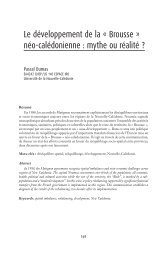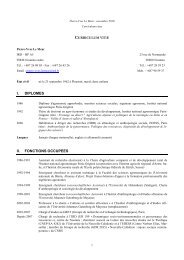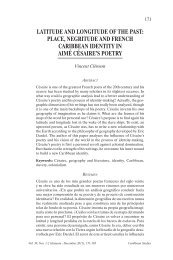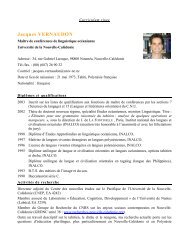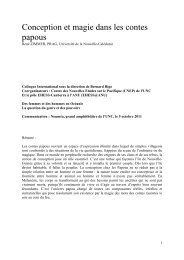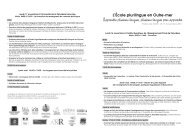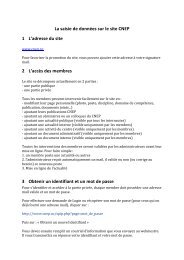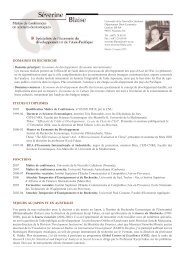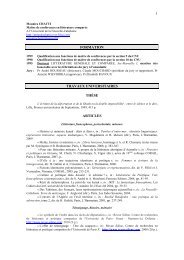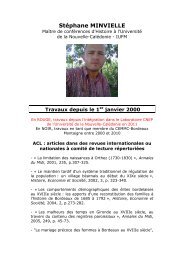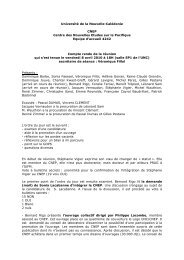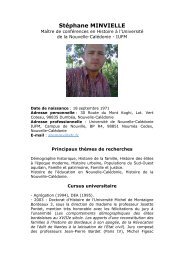assessment of soil erosion using usle model and gis for integrated ...
assessment of soil erosion using usle model and gis for integrated ...
assessment of soil erosion using usle model and gis for integrated ...
You also want an ePaper? Increase the reach of your titles
YUMPU automatically turns print PDFs into web optimized ePapers that Google loves.
Fig.2: Localisation <strong>of</strong> the weather stationsFig.3: Spatial distribution <strong>of</strong> R factorThe R values range from 1743 to 4747 MJ.mm ha -1 h -1 yr -1 . We can observe a variation <strong>of</strong> theR factor with a spatial distribution depending on the topography. Near the coasts, the R valuesare lowest (< 2500 MJ.mm ha -1 h -1 yr -1 ), while the highest mountain ranges have high values (>4500 MJ.mm ha -1 h -1 yr -1 ).III.2/ Soil erodibility: K-factorThe <strong>soil</strong> erodibility factor (K) represents the susceptibility <strong>of</strong> a <strong>soil</strong> type to <strong>erosion</strong>. The K-factor reflects the ease with which the <strong>soil</strong> is detached by splash during rainfall <strong>and</strong>/or bysurface flow, <strong>and</strong> there<strong>for</strong>e shows the change in the <strong>soil</strong> per unit <strong>of</strong> applied external <strong>for</strong>ce <strong>of</strong>energy. This factor is related to the <strong>integrated</strong> effect <strong>of</strong> rainfall, run<strong>of</strong>f, <strong>and</strong> infiltration <strong>and</strong>accounts <strong>for</strong> the influence <strong>of</strong> <strong>soil</strong> properties on <strong>soil</strong> loss during storm events on sloping areas.This factor is determined <strong>using</strong> inherent <strong>soil</strong> properties (Parysow et al., 2003). A simplermethod to predict K was presented by Wischmeier et al. (1971) which includes the particlesize <strong>of</strong> the <strong>soil</strong>, organic matter content, <strong>soil</strong> structure <strong>and</strong> pr<strong>of</strong>ile permeability. The <strong>soil</strong>erodibility factor K can be approximated from a monograph if this in<strong>for</strong>mation is known. TheUSLE monograph estimates erodibility as:1.14 −6K = 2.1×M × 10 (12 − MO)+ 0.0325×( b − 2) + 0.025×( c − 3) where M = (% silt + %very fine s<strong>and</strong>) (100- %clay), MO is the percent organic matter content, b is <strong>soil</strong> structurecode, <strong>and</strong> c is the <strong>soil</strong> permeability rating.For computing the K factor, two <strong>soil</strong> maps, one at 1/200 000 scale (Podwojewski et Beaudou,1987) available on all New Caledonia territory <strong>and</strong> the other at 1/50 000 scale available onlyon the study area (Denis et Mercky, 1982) were used. There are 22 different <strong>soil</strong>s on the area(Fig. 4), but not all <strong>soil</strong>s have in<strong>for</strong>mation about structure analysis. Thus, clusters wereoperated with similar <strong>soil</strong> classes. At the end, the study area was divided into 5 major <strong>soil</strong>classes (Table 2).Table 2: K-factors <strong>for</strong> the study areaSoil Usda class K factorAltered ferritic <strong>and</strong> ferrallitic <strong>soil</strong>s S<strong>and</strong>y loam 0.013Tropical eutrophic brown <strong>soil</strong>s, hypermagnesic, on0.022Clayultrabasic rocksDesaturated fersiallitic <strong>soil</strong>s Loam 0.03Little developed <strong>soil</strong>s <strong>of</strong> alluvial contribution, modal with0.013S<strong>and</strong>y loamvariable textureTropical eutrophic brown <strong>soil</strong>s, little developed <strong>and</strong> modal0.022Clayon basalts5



